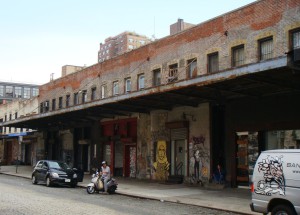 If you’re visiting New York City’s Meatpacking District in hopes of seeing actual slaughterhouses, you’re in for a surprise. The famous area hasn’t lived up to its name in some time. In fact, the area is currently known mostly for its clubs, great restaurants, upscale boutiques, exquisite architecture and the renowned High Line. So where does the meat packing and processing happen in NYC? A lot of people may be surprised to find that the city’s newest designated area to support carnivorous life is actually in The Bronx.
If you’re visiting New York City’s Meatpacking District in hopes of seeing actual slaughterhouses, you’re in for a surprise. The famous area hasn’t lived up to its name in some time. In fact, the area is currently known mostly for its clubs, great restaurants, upscale boutiques, exquisite architecture and the renowned High Line. So where does the meat packing and processing happen in NYC? A lot of people may be surprised to find that the city’s newest designated area to support carnivorous life is actually in The Bronx.
The market, located in the borough’s Hunts Point neighborhood, is one of the largest in the world. I mean, how else does one get enough burgers, bacon and pepperoni to feed 8 million people, or 22 million in the case of the current 115 wholesalers which inhabit the massive 329 acres of space. Over the past few decades, with some of the city’s largest produce and fish markets ditching lower Manhattan as well as Harlem for more space and undoubtedly cheaper rents, the area has amassed over $5 billion in sales, as recently as 2008. That number may be larger today.
The massive success, in terms of employment (the area employees some 8,000 people) and revenue, as previously mentioned, has garnered support from the city’s top officials, from both of the most recent administrations. Former mayor, Bloomberg, extended the Hunts Point’s lease through the next decade and cut the rate of annual rent by a half-million dollars. Likewise, Mayor de Blasio’s administration has bolstered the area with $150 million in support for facilities and improvements, including almost 16% designated to secure the area from natural disasters, like that experienced during the infamous Hurricane Sandy.
As focus has shifted to Hunts Point, a remnant of the original Meatpacking District are finding it more difficult than ever to remain there. At least six meatpackers inhabit a much smaller space, for a lot cheaper rent than most of the surrounding establishments. Which is part of the reason most of them are looking for new places to conduct business; once the lease ends, developers will no doubt want to drastically increase rents, or use the space to create housing in the highly-coveted area.
What this means for real estate and for those prospecting New York City within the sector, is that the city’s changing. Financial District is now spread throughout midtown and Brooklyn, and you’ll likely find more Italians in Bensonhurst than you would Little Italy. It’s important to notice shifts as they’re happening, than to benefit from them once the work has been done. Trying to get a slice of the Meatpacking pie now is going to cost more than a pretty penny. In that same regard, Hunts Point is king now, but Hunters Point–the condo-laden, upper middle class neighborhood located along the East River in Queens–could be next. Real estate evolves; the key to success is evolving with it.